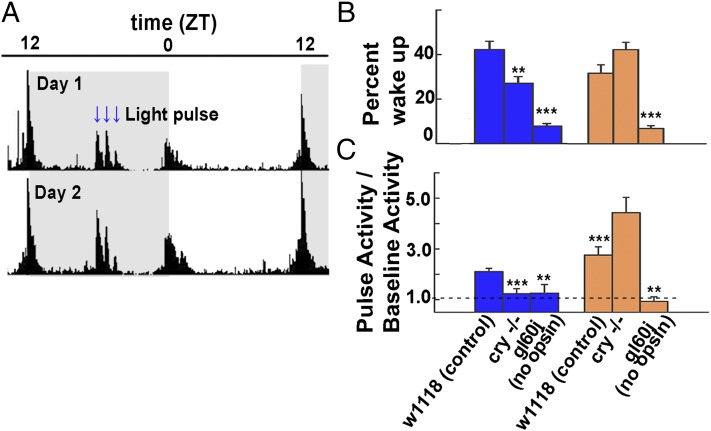Fig. 1.
Blue light activation of CRY contributes to rapid acute behavioral arousal responses. (A) Two days of averaged locomotor activity of control flies maintained in 12-h:12-h light:dark cycles. Entrainment shifts following the blue or orange nighttime light pulse protocol do not occur for any genotypes tested. (B) The averaged values of sleeping flies that wake in arousal response to blue and orange nighttime light pulses are shown for control (41 ± 4%, n = 40 blue; 32.6 ± 4%, n = 32 orange), cry−/− (26.3 ± 3%, n = 26 blue; 43.6 ± 3%, n = 17 orange), and gl60j (7.6 ± 1%, n = 14 blue; 7.1 ± 1%, n = 18 orange) mutant flies. Significantly fewer sleeping cry−/− flies wake in response to blue light pulses (P = 0.007), whereas the percentage of sleeping cry−/− flies that wake in response to orange light pulses does not differ from control (P = 0.09). Sleeping flies lacking all external opsin-based photoreceptors (gl60j mutants) show similar severe defects in their wake arousal responses to blue (P < 0.001) and orange (P = 0.001) light pulses. (C) The averaged normalized (pulse activity/baseline activity) values of behavioral arousal locomotor responses of awake flies are shown for control (2.1 ± 0.1, n = 509 blue; 2.8 ± 0.3, n = 286 orange), cry−/− (1.2 ± 0.2, n = 173 blue; 4.4 ± 0.6, n = 79 orange), and gl60j (1.3 ± 0.3, n = 86 blue; 0.9 ± 0.2, n = 112 orange) flies. The arousal response to blue light pulses is significantly attenuated in awake cry−/− flies (P = 0.002), but these flies show a significantly higher arousal response to orange light pulses (P = 0.02). In contrast, the arousal response to blue (P = 0.034) and orange (P = 0.003) light is significantly decreased in awake gl60j mutant flies. All data values and statistics are presented in detail in Dataset S1.

